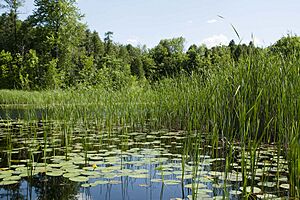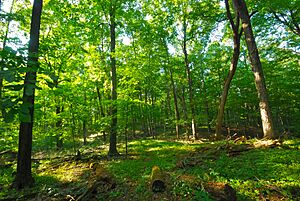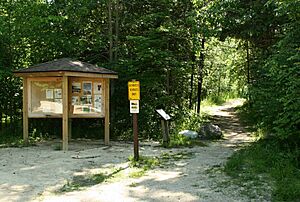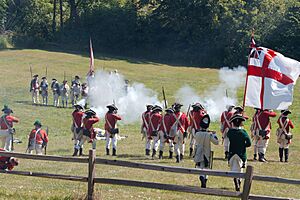Saukville (town), Wisconsin facts for kids
Quick facts for kids
Town of Saukville, Wisconsin
|
|
|---|---|

Location of Town of Saukville in Ozaukee County, Wisconsin.
|
|
| Country | United States |
| State | Wisconsin |
| County | Ozaukee |
| Settled | c. 1845 |
| Incorporated | 1848 |
| Area | |
| • Total | 33.3 sq mi (86.4 km2) |
| • Land | 32.7 sq mi (84.6 km2) |
| • Water | 0.7 sq mi (1.8 km2) |
| Elevation | 896 ft (237 m) |
| Population
(2000)
|
|
| • Total | 1,755 |
| • Density | 53.7/sq mi (20.7/km2) |
| Time zone | UTC-6 (Central (CST)) |
| • Summer (DST) | UTC-5 (CDT) |
| Area code(s) | 262 |
The Town of Saukville is a community in Ozaukee County, Wisconsin, United States. It's a place with a rich history and amazing natural areas. The nearby Village of Saukville is located inside the town's southeast part. In 2000, about 1,755 people lived here.
Long ago, Menominee and Sauk Native Americans called this area home. They lived here until the 1830s when they had to leave Wisconsin. The first European settlers arrived in the mid-1840s. The Town of Saukville was officially created in 1848. Early settlers were mostly farmers, and by the early 1900s, dairy farming was very important.
In 1915, the Village of Saukville became its own separate community, taking some land from the town. While the village has grown with more businesses, farming is still a big part of the Town of Saukville's economy.
The town is also famous for its beautiful natural spaces. It has thousands of acres of bogs, coniferous swamps, and old forests. The biggest natural area is the 2,200-acre Cedarburg Bog State Natural Area. These bogs are home to many rare plants and animals, including carnivorous plants! One special feature is a string bog, which is very rare to find this far south.
Contents
Saukville's Past: A Look at History
Early Settlers and Native Americans
Saukville was once a Native American village. It was located where two important trails crossed, one of which became Green Bay Road. It was also by the Milwaukee River. The people living there were likely Menominee and Sauk people.
In the 1830s, these Native American groups were asked to leave Wisconsin. Around 1845, new settlers arrived and began building homes along Green Bay Road.
Growing Up: From Town to Village
Saukville was first part of the Town of Port Washington. But in 1848, the Town of Saukville was created. For many years, Saukville was a quiet farming community, especially known for its dairy farms. In 1871, a train track was built through Saukville. This track later became part of the Chicago, Milwaukee & St. Paul Railway.
Later, in 1915, the Village of Saukville officially formed, taking some land from the town. Then, in 1973, the Village of Newburg also became a separate village. It took land from both the Town of Saukville and the nearby Town of Trenton.
Exploring Saukville's Geography

Land and Water: Where Saukville Is
The Town of Saukville covers about 33.3 square miles (86.4 km2). Most of this is land, with a small part being water. The Village of Saukville is located in what used to be the southeast part of the town.
Saukville shares its borders with several other towns and villages. To the north are Waubeka, the Town of Fredonia, and the Village of Fredonia. To the east is the Town of Port Washington. To the south, you'll find the Town of Grafton and the Cedarburg (town), Wisconsin. And to the west are the Town of Trenton and the Village of Newburg.
Glaciers and Rocks: How the Land Formed
Saukville is in an area shaped by glaciers during the last ice age. This means you can find many interesting landforms like kames (small hills), kettles (hollows), and moraines (ridges of rock and dirt).
Much of the town sits on a rock layer called the Racine Dolomite formation. This rock contains Silurian marine fossils, which are remains of ancient sea creatures. While most of this rock is deep underground, you can see fossils in old quarries in the Village of Saukville. You can also see them in a 50-foot-high cliff along the Milwaukee River at Riveredge Nature Center.
Amazing Nature: Forests and Bogs
Before settlers arrived, Saukville was covered in forests of American beech and sugar maple trees. There were also white cedars along the Milwaukee River and thousands of acres of coniferous swamps. Most of the original forest was cleared for farming.
However, the Cedarburg Beech Woods State Natural Area still has old, untouched trees. It looks much like the forests did before people settled here.
The town has many nature preserves. The largest is the Cedarburg Bog State Natural Area. This 2,200-acre area is a National Natural Landmark because it has so many different kinds of plants and animals. It's the biggest and best-preserved bog in eastern Wisconsin. It has two lakes, large white cedar and tamarack swamps, and the southernmost string bog on Earth.
Special Plants and Animals
The Cedarburg Bog is home to several carnivorous plant species. These include bladderworts, pitcher plants, and round-leafed sundews. The U.S. Fish and Wildlife Service also says the Cedarburg Bog is important for the endangered Hine's emerald dragonfly.
Other bogs in Saukville have black spruce swamps, which are rare so far south. You can also find plants like leatherleaf, snakemouth orchids, grass-pink orchids, bog-rosemary, winterberry, blueberry, and cranberry. The town is also home to the threatened forked aster and the American gromwell, a plant of special concern.
As more land is developed, wild animals sometimes come closer to towns like Saukville. You might see large mammals like white-tailed deer, coyotes, North American river otters, and red foxes. Many birds, including great blue herons and wild turkeys, live here. The swamps and bogs are also great places for birds like the osprey.
Dealing with Invasive Species
The area faces challenges from invasive species. These are plants and animals that are not native and can harm the local environment. Some examples include the emerald ash borer (an insect), common carp (a fish), and plants like reed canary grass, the common reed, purple loosestrife, garlic mustard, Eurasian buckthorns, and honeysuckles.
Saukville's People: Demographics
In 2000, the Town of Saukville had 1,755 people living in 622 households. Most people (98.29%) were White. About 35.2% of households had children under 18. The average household had 2.82 people.
The population was spread out by age:
- 26.5% were under 18
- 5.5% were 18 to 24
- 28.3% were 25 to 44
- 28.4% were 45 to 64
- 11.3% were 65 or older
The average age was 40 years.
Learning in Saukville: Education
The Town of Saukville has two main public school districts. They are the Port Washington-Saukville School District and the Northern Ozaukee School District. The Northern Ozaukee School District also serves Fredonia, Newburg, and parts of the Town of Belgium.
- Students in the Port Washington-Saukville School District go to:
- Saukville Elementary School (kindergarten to 4th grade)
- Thomas Jefferson Middle School (5th to 8th grades)
- Port Washington High School (9th to 12th grades)
- Students in the Northern Ozaukee School District go to:
- Ozaukee Elementary School (kindergarten to 5th grade)
- Ozaukee Middle School (6th to 8th grades)
- Ozaukee High School (9th to 12th grades)
There's also the Riveredge School, a free public elementary charter school. It's located at the Riveredge Nature Center in the northwest part of the town. This school teaches children from kindergarten to 5th grade.
The University of Wisconsin–Milwaukee Field Station is a 320-acre nature preserve and laboratory next to the Cedarburg Bog State Natural Area. It's used by university students and teachers for science research. It's not open to the public.
Getting Around: Transportation
Interstate 43 runs through the southeast part of the Town of Saukville. Exit 96 leads to the Village of Saukville. Wisconsin Highway 57 and Wisconsin Highway 33 also go through the town.
Public transportation in Saukville is limited compared to bigger cities. Ozaukee County and the Milwaukee County Transit System have a bus route called the "Ozaukee County Express." This bus goes to Milwaukee via Interstate 43. It stops in the Saukville Walmart parking lot, which is its last stop to the north. The bus runs Monday through Friday during busy travel times.
Ozaukee County Transit Services also offers a Shared Ride Taxi. This taxi service can take you to places not on the bus route. It runs seven days a week and can connect you to other transit services in Washington and Milwaukee Counties.
The Wisconsin and Southern Railroad has a freight train line that goes through the eastern part of the town. There is no passenger train station in Saukville right now.
Fun in Saukville: Nature Preserves, Parks and Recreation
State Natural Areas
- Cedarburg Beech Woods: This 74-acre nature preserve is owned by the University of Wisconsin-Milwaukee. It has tamarack swamps and old beech-maple forests. These forests are like the ones that covered Ozaukee County before settlers cleared much of the land for farming.
- Cedarburg Bog: This 2,200-acre National Natural Landmark is very diverse. It has hiking trails that let you see the largest and best-preserved bog in eastern Wisconsin. There's also a boardwalk and a birdwatching platform on Mud Lake.
- Riveredge Creek and Ephemeral Pond: The Riveredge Nature Center is a private, non-profit group that cares for this 61-acre nature preserve. It's full of plants and insects near where Riveredge Creek meets the Milwaukee River. The center has landforms left by glaciers and 50-foot-high cliffs along the river.
- Sapa Spruce Bog: This 24-acre nature preserve is also owned by the University of Wisconsin-Milwaukee. It's a unique bog located farther south than most black spruce-tamarack bogs. It has a special ecosystem with plants and animals, including six types of Sphagnum moss, that are not usually found this far south.
Ozaukee County Parks
- Ehlers Park: This is a narrow seven-acre park along the Milwaukee River. It has 2,200 feet of riverfront, perfect for launching canoes and fishing.
- Hawthorne Hills Park, H. H. Peters Youth Camp, and Ozaukee County Pioneer Village: These three county parks are located together in northeastern Saukville on the Milwaukee River.
- Hawthorne Hills Park has 57 acres of forest with hiking trails and an 18-hole golf course.
- The H. H. Peters Youth Camp is 40 acres with hiking trails connected to Hawthorne Hills. It has a camp hall with showers and restrooms.
- Pioneer Village is an open-air museum with twenty-four old buildings from the 1840s to the early 1900s. It shows what village life was like in early Ozaukee County.
- Tendick Nature Park: This 122-acre park has a boardwalk through wetlands, a canoe launch on the Milwaukee River, an archery range, and picnic areas.
Ozaukee Washington Land Trust
- Shannon Preserve: This 34-acre nature preserve has hardwood forests, cattail swamps, and a lake. It offers hiking trails and great opportunities for birdwatching.
Additionally, the Blue Heron Wildlife Sanctuary is a private, non-profit nature center on the Milwaukee River. It has 92 acres of land, hiking trails, and facilities for helping injured wildlife. You might even spot North American river otters from the trails!
The Town of Saukville is also home to The Bog, a private, 18-hole golf course located east of the Cedarburg Bog.
See also
 In Spanish: Saukville (condado de Ozaukee, Wisconsin) para niños
In Spanish: Saukville (condado de Ozaukee, Wisconsin) para niños






